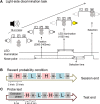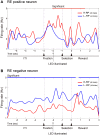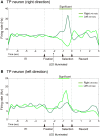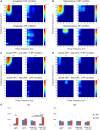Oscillatory interaction between amygdala and hippocampus coordinates behavioral modulation based on reward expectation
- PMID: 24348352
- PMCID: PMC3847563
- DOI: 10.3389/fnbeh.2013.00177
Oscillatory interaction between amygdala and hippocampus coordinates behavioral modulation based on reward expectation
Abstract
The aim of this study is to examine how the amygdala and hippocampus interact for behavioral performance modulated by different Reward-expectations (REs). We simultaneously recorded neuronal spikes and local field potential from the basolateral amygdala and hippocampal CA1 while rats were performing a light-side discrimination task with different expectations of a high or low probability of reward delivery. Here, we report the following results. First, the rats actually modulated their behavioral performance on their expectations of a high or low probability of reward. Second, we found more neurons related to RE in the amygdala and more neurons related to task performance in the hippocampus. Third, a prominent increase in the coherence of high-frequency oscillations (HFOs) (90-150 Hz) between the amygdala and the hippocampus was present during high RE. Fourth, coherent HFOs during inter-trial intervals and theta coherence during trials had significant correlations with the behavioral goal-selection time. Finally, cross-frequency couplings of LFPs within and across the amygdala and hippocampus occurred during ITI. These results suggest that the amygdala and hippocampus have different functional roles in the present task with different REs, and the distinctive band of coherence between the amygdala and the hippocampus contributes to behavioral modulation on the basis of REs. We propose that the amygdala influences firing rates and the strength of synchronization of hippocampal neurons through coherent oscillation, which is a part of the mechanism of how reward expectations modulate goal-directed behavior.
Keywords: amygdala; behavioral modulation; hippocampus; oscillation synchrony; reward expectation.
Figures








Similar articles
-
Integrated Amygdala, Orbitofrontal and Hippocampal Contributions to Reward and Loss Coding Revealed with Human Intracranial EEG.J Neurosci. 2022 Mar 30;42(13):2756-2771. doi: 10.1523/JNEUROSCI.1717-21.2022. Epub 2022 Feb 11. J Neurosci. 2022. PMID: 35149513 Free PMC article.
-
Reward Expectancy Strengthens CA1 Theta and Beta Band Synchronization and Hippocampal-Ventral Striatal Coupling.J Neurosci. 2016 Oct 12;36(41):10598-10610. doi: 10.1523/JNEUROSCI.0682-16.2016. J Neurosci. 2016. PMID: 27733611 Free PMC article.
-
Optogenetic Stimulation of the Basolateral Amygdala Increased Theta-Modulated Gamma Oscillations in the Hippocampus.Front Behav Neurosci. 2019 Apr 30;13:87. doi: 10.3389/fnbeh.2019.00087. eCollection 2019. Front Behav Neurosci. 2019. PMID: 31114488 Free PMC article.
-
High-frequency oscillations are prominent in the extended amygdala.J Neurophysiol. 2014 Jul 1;112(1):110-9. doi: 10.1152/jn.00107.2014. Epub 2014 Apr 9. J Neurophysiol. 2014. PMID: 24717353 Free PMC article.
-
Parallel processing across neural systems: implications for a multiple memory system hypothesis.Neurobiol Learn Mem. 2004 Nov;82(3):278-98. doi: 10.1016/j.nlm.2004.07.007. Neurobiol Learn Mem. 2004. PMID: 15464410 Review.
Cited by
-
Theta oscillation and neuronal activity in rat hippocampus are involved in temporal discrimination of time in seconds.Front Syst Neurosci. 2015 Jun 22;9:95. doi: 10.3389/fnsys.2015.00095. eCollection 2015. Front Syst Neurosci. 2015. PMID: 26157367 Free PMC article.
-
Volitional enhancement of firing synchrony and oscillation by neuronal operant conditioning: interaction with neurorehabilitation and brain-machine interface.Front Syst Neurosci. 2014 Feb 6;8:11. doi: 10.3389/fnsys.2014.00011. eCollection 2014. Front Syst Neurosci. 2014. PMID: 24567704 Free PMC article. Review.
-
Reward-related dynamical coupling between basolateral amygdala and nucleus accumbens.Brain Struct Funct. 2020 Jul;225(6):1873-1888. doi: 10.1007/s00429-020-02099-2. Epub 2020 Jun 18. Brain Struct Funct. 2020. PMID: 32556583 Free PMC article.
-
Phase organization of network computations.Curr Opin Neurobiol. 2015 Apr;31:250-3. doi: 10.1016/j.conb.2014.12.011. Epub 2015 Feb 11. Curr Opin Neurobiol. 2015. PMID: 25679370 Free PMC article. Review.
-
Emergence of β-Band Oscillations in the Aged Rat Amygdala during Discrimination Learning and Decision Making Tasks.eNeuro. 2017 Oct 6;4(5):ENEURO.0245-17.2017. doi: 10.1523/ENEURO.0245-17.2017. eCollection 2017 Sep-Oct. eNeuro. 2017. PMID: 29034315 Free PMC article.
References
LinkOut - more resources
Full Text Sources
Other Literature Sources
Miscellaneous

